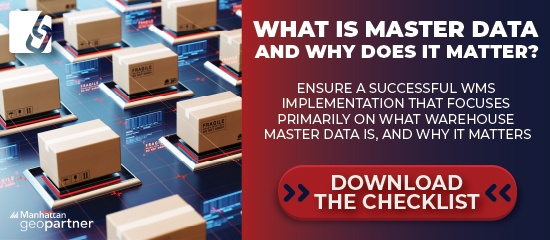5 common onboarding mistakes with your warehouse management system (WMS)

.png) The right warehouse management system is a powerful productivity tool when implemented successfully. Here’s a list of common onboarding mistakes and how to avoid them.
The right warehouse management system is a powerful productivity tool when implemented successfully. Here’s a list of common onboarding mistakes and how to avoid them.
Mistake #1 | Your implementation schedule was unrealistic
Mistake #2 | You didn’t align your business goals
Mistake #3 | Your physical warehouse wasn’t ready for a WMS
Mistake #4 | Your team composition didn’t include the right staff
Mistake #5 | You didn’t allocate sufficient time for training and change management
In an ever changing and demanding marketplace, you can’t afford to fall behind.
A warehouse management system (WMS) can help streamline your processes and give you valuable insight into your business. It’s not uncommon, however, to experience a speed hump or two when implementing new systems or processes in your warehouse.
Preparing for your warehouse management software will save you countless headaches in the long run.
The best thing you can do in preparation for your WMS, is learn from the mistakes of those who’ve gone through onboarding before you. That’s why we’ve put together this list of common onboarding errors, which will help you avoid falling in to the same traps during your WMS implementation.
Mistake #1 | Your implementation schedule was unrealistic
One of the biggest mistakes a first-time WMS user can make is to expect to go from zero to hero in a day.

Image source: Giphy
In fact, it typically takes between six to eight months to successfully implement a WMS. Implementing a WMS is a journey of incremental improvement. Through constant tweaking and optimisation, you’ll continue to see improvements well after the initial go-live date.
Mistake #2 | You didn’t align your business goals
We often see that our customers are very unclear on what they wish to achieve from the software. This includes things like timelines, ramp up volumes, new business process objectives and return on investment (ROI).

Warehouse management systems are mission-critical technologies, and your decision shouldn’t be made impulsively. You can’t, for example, rush out and buy a low-cost system and then expect high-end results.
You should keep in mind that your WMS is an ever-evolving strategic tool that supports your company’s long term strategy and goals. At the same time, it needs to be adaptive under dynamic and changing market conditions, rather than a tactical point solution which only fixes short term problems.
Read our article, What defines a successful WMS implementation, for tips to ensure a smooth onboarding process.
Things you need to consider when choosing a WMS include:
- Whether you require Voice or RF picking. This depends on how hands-free your picking operation is, what your current picking challenges are and what the ROI will be.
- How the WMS will integrate with existing systems and technology in your warehouse. Your WMS typically needs to integrate with an ERP and, potentially, a TMS as well. This all depends on your business requirements - but there are generally standard touchpoints (e.g. item master, purchase orders and customer orders).
- What are your master data requirements? The more complete your SKU and warehouse master data is, the more benefit you will receive from the WMS.
To ensure your master data is correct, download our “Successful WMS Implementation Master Data Implementation Checklist.”
- Whether you want to host your data in the cloud on on premise. This is entirely up to you and will depend on your business needs. Whether you choose a private (on premise), public (third party hosting) or hybrid (combination of private and public) cloud solution will depend on the nature and sensitivity of the data you wish to store.
When starting projects, the first thing we do is “align” the system functionality to the actual business’ requirements. It’s also crucial to know what your measurement criteria are from the start - that way you have a benchmark to track your progress against your business goals.
Mistake #3 | Your physical warehouse wasn’t ready for a WMS
You wouldn’t buy a packet of popcorn without having a stove or microwave to cook it in - you’d be stuck staring at a packet of kernels. The same applies to your WMS. It’s all well and good having top-end software, but if you don’t have the right conditions or tools to implement it, you won’t see the results you hoped for.
A WMS is only as good as the warehouse you’re implementing it in. You need to make sure you’ve planned your warehouse flow, material handling, storage and so on, in a way that maximises the benefits of your WMS.
Mistake #4 | Your team composition didn’t include the right staff
We often see that customers don’t allocate the right team members to the WMS implementation project.
Your WMS implementation team should include staff from internal project and change management, to IT integrations, infrastructure, operations and a WMS champion.
Mistake #5 | You didn’t allocate sufficient time for training and change management
Often businesses don’t allocate enough time for staff to focus on the project related activities. This can result in disgruntled staff who struggle to use the WMS and accept new processes.
If you want your WMS implementation to run smoothly, you need to prepare your team appropriately. You should ensure that staff have enough time for training, testing and change management.
One of the biggest challenges when implementing change, is getting staff buy-in (without which, your project will encounter delays). Warehouse workers in particular are at risk of being resistant to change, for fear of losing their jobs as a result of automation. The best way to avoid this, is to tackle the beast head on. Be completely transparent during the onboarding process. Address their concerns immediately by answering their questions about how the WMS will affect them and their jobs, and you’ll be less likely to run into resistance.
Need help finding the right WMS for your warehouse? Our supply chain experts will perform a needs analysis on your warehouse to help you find the perfect solution to support your business goals.
Get all the latest articles from our Supply Chain experts delivered straight to your inbox. Subscribe to our blog and never miss a post.
TAGS
- WMS (50)
- Warehouse Best Practice (46)
- Implementing a WMS (29)
- Managing your warehouse (19)
- Omni Channel (18)
- eCommerce (18)
- Blog (16)
- Supply Chain Best Practice (16)
- Customer Journey (8)
- Mid-Level (8)
- Warehouse optimisation (7)
- General Tips (5)
- Industry General (5)
- Information (5)
- managing your Supply Chain (5)
- saudi arabia (5)
- Trends (4)
- smart warehouse (4)
- 3PL (3)
- News (3)
- ERP (2)
- Entry-level (2)
- ROI (2)
- Case Study (1)
- OMS (1)
- Picking (1)
- Press Release (1)
- Solution-Specific (1)
- Transport Management System (1)
Take A Look At The Results Of A Successful WMS Implementation.
See how Tarsus Distribution, in collaboration with SCJ boost overall efficiency by 60%







